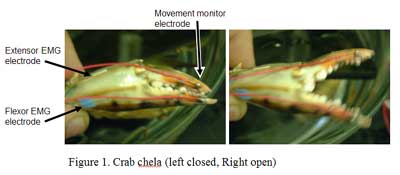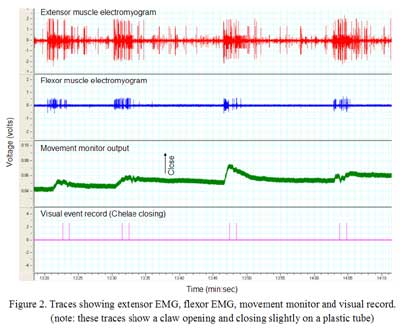An Electronic Movement Monitor
A story of electronic design
One innovation that came out of the electrophysiology experiments with the octopus buccal mass was the creation of a device used to measure the changing distance between two points under seawater. This invention was born of the need to correlate movement to the activation pattern of the muscles. The problem was how to transduce small linear distances underwater into voltages that could be recorded along with differential electromyograms using an analog to digital converter.
In reviewing the literature on how to create such an instrument, I found a 1976 electronics paper that amplified and recorded the tiny resistance of saltwater between two emitter electrodes and a sensor electrode to record changes in the angels of arthropod joints. While in England, my advisor had successfully used a modification of the circuit in order to measure the up and down movement of a cuttlefish fin. I decided to try this technique on the jaws, however, I needed a design that required only two miniature electrodes. I decided to try and track down the authors of the original paper, and found suprisingly that one of them was designing analog and digital wonders and teaching biomedical instrumentation in a building just two doors down. Together Dr. Hsiao and I developed a new device that uses two very small silver chloride ball electrodes to measure distances of up to a centimeter with a resolution of about 1.5 volts. These days I count Dr. Hsiao as a really good friend and a great mentor who always has a cheerful and wise word to pass along. In fact, we're in the process of publishing the technique right now!
Below are some results of a test with a very simple preparation: a crab claw. Figure 1 shows the claw opening and closing. Figure 2 shows a trace. It's interesting that the opening and closing muscles are active at the same time and may be an indication of an interesting quirk of crustacean physiology; they have both fast and slow excitatory neurons as well as inhibitory neurons.


Details of how you can use this technique has now been published in the Journal of Invertebrate Biology. To contact me regarding questions or ideas please go to my contact information area. To find reprints of my research projects, please click here.

Project Areas
Gastropods |
Muscle Articulations |
Bullfrogs |
The Heart |
Techniques |